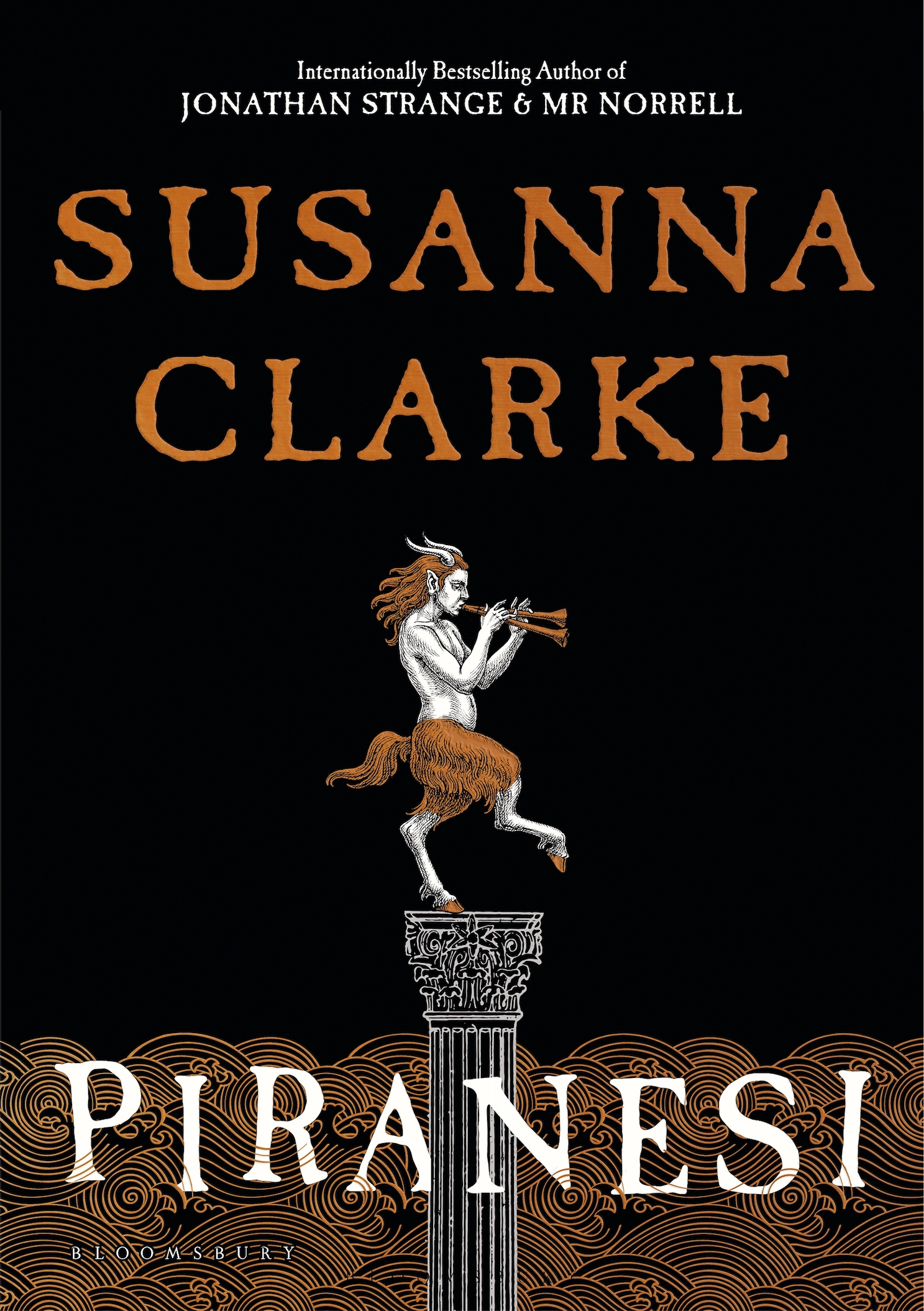Susanna Clarke: Piranesi review - the mysteries of the House | reviews, news & interviews
Susanna Clarke: Piranesi review - the mysteries of the House
Susanna Clarke: Piranesi review - the mysteries of the House
Mind-bending adventures in a splendid, and sinister, dreamworld

The man called Piranesi lives in a House (he likes Capital Letters, and he tells the story). This House consists of an endless labyrinth, like “an infinite series of classical buildings knitted together”. Each of its Halls measures “approximately 200 metres in length and 120 metres wide” (pretty much the Golden Ratio of classical art and architecture). Alcoves and niches in each Hall contain a multitude of symbolic Statues that resemble Baroque tableaux of ancient myths.
We have waited a long time to meet Piranesi. In 2004, Susanna Clarke published Jonathan Strange & Mr Norrell, her epic, learned, playful tale of rival Regency magicians in a beautifully confected parallel England. That novel made the formal barriers between fantasy, historical and “literary” fiction vanish as if crumbled by a spell, as did (in her virtuoso pastiche) the stylistic fences between Jane Austen and early Dickens. In 2007, Clarke revisited the edgelands between reason and magic in the stories of The Ladies of Grace Adieu. Piranesi, too, dwells from time to time on margins, portals and thresholds, and on the tantalising idea of “a door between us and wherever magic had gone”. For its first two-thirds, however, we must find our meanings within the House itself. Piranesi reveres his home as a self-sufficient universe that satisfies all needs and answers all questions: “The Beauty of the House is immeasurable; its Kindness infinite.”
Even in his narration, though, we spot alien intrusions. They include “old fish-finger packets and sausage-roll wrappings”. As for the Vestibule, it harbours not only “eight massive Statues of Minotaurs” (now there’s a warning to the Reader) but a nasty draught that brings “a smell of rain, metal and petrol”. The Other, a pedantic, self-important scholar of some kind, possesses a small “shining device” and enters data into it. Lacking Piranesi’s faith and innocence, he considers the House as a trove of “Great and Secret Knowledge” hidden, like treasure, somewhere within it.
 Piranesi, in contrast, refuses to treat it as “a sort of riddle to be unravelled” but resides happily in a place he finds “enough in and of Itself”. But the contaminations multiply. He discovers journals he cannot remember ever writing, full of weird stories about unknown people and nonsense words such as “Manchester”, “university” and “police station”. In the Halls he encounters a rather camp elderly sage, whom he names the Prophet. This drawling guru speaks derisively of the Other. He alludes to a disenchantment of the world that has left forgotten knowledge, the “wisdom of the ancients”, to flow secretly into places invisible to the eyes of reason and science. Then Piranesi hears rumours of another human visitor, “16”, whose entry into the Halls will trigger a transforming crisis.
Piranesi, in contrast, refuses to treat it as “a sort of riddle to be unravelled” but resides happily in a place he finds “enough in and of Itself”. But the contaminations multiply. He discovers journals he cannot remember ever writing, full of weird stories about unknown people and nonsense words such as “Manchester”, “university” and “police station”. In the Halls he encounters a rather camp elderly sage, whom he names the Prophet. This drawling guru speaks derisively of the Other. He alludes to a disenchantment of the world that has left forgotten knowledge, the “wisdom of the ancients”, to flow secretly into places invisible to the eyes of reason and science. Then Piranesi hears rumours of another human visitor, “16”, whose entry into the Halls will trigger a transforming crisis.
Readers will unravel the riddle of Piranesi – its hero named for the 18th-century Venetian artist of geometrically impossible spaces and vistas (pictured above: "The Pier with Chains" from Imaginary Prisons (1750) – in many different ways. Indeed, on one plane you can choose to decipher it as hermeneutic fiction, about paranoid sense-making, over-interpretation, and the perils of experiencing your House (your World) as a labyrinth of clues rather than an abode of wonders. When, at the end, Piranesi reflects on the Other (who by now has a name), his antagonist reminds him of one particular Statue, depicting a man with a broken sword beside a fragmented sphere. “The man has used his sword to shatter the sphere because he wanted to understand it, but now he finds that he destroyed both sphere and sword.” The fable also hints at the importance of maintaining “a path between worlds” rather than becoming trapped behind one door or another. Piranesi – who thinks like a sort of self-made Platonist – champions his beloved Statues as ideal forms, superior to the things they represent, “being perfect, eternal and not subject to decay”. As do idealists of all stripes. And, perhaps, artists as well.
 The denouement, which I will not reveal, opens pathways into naturalistic as well as supernatural explanations. Without stepping too far into the Hall where Spoilers lie, we can say that the survival of magical thinking and magical belief – as a mental and cultural substratum, if not a sociological phenomenon – figures here, as it did in Clarke’s glorious debut. Her prowess as a stylist is undiminished, too. If she leads us through a metaphysical maze to equal the library-labyrinths of Jorge-Luis Borges, her drily sardonic take on these abysses of the mind feels closer in tone of Mervyn Peake’s Gormenghast novels. Piranesi’s naively observant voice also nods to the narrators of those Enlightenment parables of flawed Reason lost amid marvels and monsters – think Defoe’s Crusoe, Swift’s Gulliver, Voltaire’s Candide. And, if the opening movements of Piranesi make an elegant contribution to the tradition of the esoteric underground in English prose – from 17th-century Rosicrucians, through fin-de-siècle Neo-Pagans, to the age of Christopher Priest and Neil Gaiman – then its final act feels more like a witty satire on the pursuit of occult lore.
The denouement, which I will not reveal, opens pathways into naturalistic as well as supernatural explanations. Without stepping too far into the Hall where Spoilers lie, we can say that the survival of magical thinking and magical belief – as a mental and cultural substratum, if not a sociological phenomenon – figures here, as it did in Clarke’s glorious debut. Her prowess as a stylist is undiminished, too. If she leads us through a metaphysical maze to equal the library-labyrinths of Jorge-Luis Borges, her drily sardonic take on these abysses of the mind feels closer in tone of Mervyn Peake’s Gormenghast novels. Piranesi’s naively observant voice also nods to the narrators of those Enlightenment parables of flawed Reason lost amid marvels and monsters – think Defoe’s Crusoe, Swift’s Gulliver, Voltaire’s Candide. And, if the opening movements of Piranesi make an elegant contribution to the tradition of the esoteric underground in English prose – from 17th-century Rosicrucians, through fin-de-siècle Neo-Pagans, to the age of Christopher Priest and Neil Gaiman – then its final act feels more like a witty satire on the pursuit of occult lore.
Indeed, some readers may feel that Clarke delivers too much disenchanting information at the close. Her note-perfect control of voice and vision, which makes the first parts of Piranesi such a hermetic delight, falters a little when more mundane material seeps in through the doors. The central mystery remains, however, as spaciously enigmatic as the House itself.
- Piranesi by Susanna Clarke (Bloomsbury, £14.99)
The future of Arts Journalism
You can stop theartsdesk.com closing!
We urgently need financing to survive. Our fundraising drive has thus far raised £49,000 but we need to reach £100,000 or we will be forced to close. Please contribute here: https://gofund.me/c3f6033d
And if you can forward this information to anyone who might assist, we’d be grateful.

Subscribe to theartsdesk.com
Thank you for continuing to read our work on theartsdesk.com. For unlimited access to every article in its entirety, including our archive of more than 15,000 pieces, we're asking for £5 per month or £40 per year. We feel it's a very good deal, and hope you do too.
To take a subscription now simply click here.
And if you're looking for that extra gift for a friend or family member, why not treat them to a theartsdesk.com gift subscription?
more Books
 'We are bowled over!' Thank you for your messages of love and support
Much-appreciated words of commendation from readers and the cultural community
'We are bowled over!' Thank you for your messages of love and support
Much-appreciated words of commendation from readers and the cultural community
 Justin Lewis: Into the Groove review - fun and fact-filled trip through Eighties pop
Month by month journey through a decade gives insights into ordinary people’s lives
Justin Lewis: Into the Groove review - fun and fact-filled trip through Eighties pop
Month by month journey through a decade gives insights into ordinary people’s lives
 Joanna Pocock: Greyhound review - on the road again
A writer retraces her steps to furrow a deeper path through modern America
Joanna Pocock: Greyhound review - on the road again
A writer retraces her steps to furrow a deeper path through modern America
 Mark Hussey: Mrs Dalloway - Biography of a Novel review - echoes across crises
On the centenary of the work's publication an insightful book shows its prescience
Mark Hussey: Mrs Dalloway - Biography of a Novel review - echoes across crises
On the centenary of the work's publication an insightful book shows its prescience
 Frances Wilson: Electric Spark - The Enigma of Muriel Spark review - the matter of fact
Frances Wilson employs her full artistic power to keep pace with Spark’s fantastic and fugitive life
Frances Wilson: Electric Spark - The Enigma of Muriel Spark review - the matter of fact
Frances Wilson employs her full artistic power to keep pace with Spark’s fantastic and fugitive life
 Elizabeth Alker: Everything We Do is Music review - Prokofiev goes pop
A compelling journey into a surprising musical kinship
Elizabeth Alker: Everything We Do is Music review - Prokofiev goes pop
A compelling journey into a surprising musical kinship
 Natalia Ginzburg: The City and the House review - a dying art
Dick Davis renders this analogue love-letter in polyphonic English
Natalia Ginzburg: The City and the House review - a dying art
Dick Davis renders this analogue love-letter in polyphonic English
 Tom Raworth: Cancer review - truthfulness
A 'lost' book reconfirms Raworth’s legacy as one of the great lyric poets
Tom Raworth: Cancer review - truthfulness
A 'lost' book reconfirms Raworth’s legacy as one of the great lyric poets
 Ian Leslie: John and Paul - A Love Story in Songs review - help!
Ian Leslie loses himself in amateur psychology, and fatally misreads The Beatles
Ian Leslie: John and Paul - A Love Story in Songs review - help!
Ian Leslie loses himself in amateur psychology, and fatally misreads The Beatles
 Samuel Arbesman: The Magic of Code review - the spark ages
A wide-eyed take on our digital world can’t quite dispel the dangers
Samuel Arbesman: The Magic of Code review - the spark ages
A wide-eyed take on our digital world can’t quite dispel the dangers
 Zsuzsanna Gahse: Mountainish review - seeking refuge
Notes on danger and dialogue in the shadow of the Swiss Alps
Zsuzsanna Gahse: Mountainish review - seeking refuge
Notes on danger and dialogue in the shadow of the Swiss Alps
 Patrick McGilligan: Woody Allen - A Travesty of a Mockery of a Sham review - New York stories
Fair-minded Woody Allen biography covers all bases
Patrick McGilligan: Woody Allen - A Travesty of a Mockery of a Sham review - New York stories
Fair-minded Woody Allen biography covers all bases

Add comment